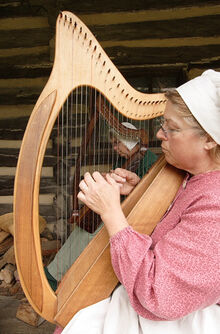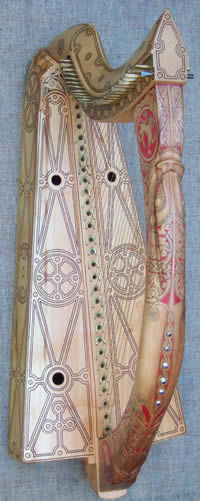
Wikipedia Commons. Reenactors playing celtic harp. Retrieved from http://commons.wikimedia.org/wiki/File:Celtic_harps.JPG
The wire-strung harp, often called the clarsach, is a unique harp strung entirely with metal, as opposed to nylon and/or gut stringing. The sound is distinctive, often likened to the tinkling of bells, and characterized by a long sustain. “Clàrsach or Cláirseach (depending on Scottish Gaelic or Irish spellings), is the generic Gaelic word for ‘a harp’, as derived from Middle Irish. In English, the word is used to refer specifically to a variety of small Irish and Scottish harps. The use of this word in English, and the varieties of harps that it describes, is very complex and is a cause of arguments or disagreements between different groups of harp-lovers. By and large, in English, the word clàrsach is equivalent to the term Irish harp, the former being preferred in Scottish contexts and the latter in Irish contexts. The precise Gaelic term for the harp of the Gael is clàrsach Ghàidhealach (Sc.)/cláirseach Ghaelach (Ir.), meaning Gaelic harp.” [1]
Development[]
The clarsach is known to date at least to the 11th century if not earlier. “The Gaelic triangular, wire-strung harp has always been known by the feminine term cruit but by 1204 was certainly known by the masculine term ‘clàr‘ (board) and, by the 14th century, by the feminine form of ‘clàr‘, i.e., ‘clàirseach/clàrsach’. “ [1]
“The small harp was a common enough instrument in medieval Europe. It was fairly light, was usually strung with gut or hair, played with finger pads, and was used mostly to accompany, or in ensemble work. In contrast to this, the Irish made a strong heavy harp, strung it with brass wire, and played it with long crooked finger nails” [2] The wire-strung harp needed to be stronger and heavier to withstand the tension of metal strings.
There was a lively interchange of ideas and music between Irish, Scottish, and Welsh harpers, although Welsh harps were typically strung with horsehair and were called telyn, stemming from an Irish word meaning the humming or buzzing of a bee. These harps reportedly produced a low humming sound, quite different than the resonance of wire-strung harps (for an interesting look at the attempted reproduction of these harps see Project Telyn Rawn).
Irish and Scottish harp players enjoyed a high standing, often retained by wealthy households. By the late 18th century, however, the wire harp tradition had largely died out. The popularity of the piano and other forms of contemporary music contributed to itsdemise. In 1792, the Belfast Harpers’ Festival was organized to celebrate Ireland’s ancient musical roots. Although the call for harpers was spread far and wide, only ten harpers came to the festival. The oldest of these harpers was 97, and the youngest 15, but the bulk of the remaining players were in their fifties, with two in their mid-seventies. Six of the ten harpers were blind. Fortunately, their traditional songs were recorded by Edward Bunting for posterity.

Wikipedia Commons. Replica of the 15th century medieval Scottish clarsach known as the ‘Queen Mary Harp’, built by Irish harpmaker Davy Patton, 2006-7, and owned and played by historical harp expert Simon Chadwick. Retrieved
Close to 200 years later, in the 1960s and 1970s, a revival of folk music and instruments led to the resurrection of interest in the wire-strung harp. Alan Stivell was among the first to rediscover the charm of the early music of the wire harp, as was Minneapolis musician Ann Heymann who came across Bunting’s collection of early Irish harp music and became intrigued enough to devote herself entirely to the study and playing of the Gaelic harp. She went on to lead the way in unearthing traditional methods of construction and playing techniques. Today there is a small but growing community of wire-strung harp aficionados, and several well-known musicians specializing in this beautiful instrument, such as Cynthia Cathcart, Chad McAnally, Simon Chadwick, Siobhán Armstrong, Patrick Ball, and others.
Construction[]
Not all contemporary wire-strung harps are built according to traditional designs, but most attempt to approximate extant historical exemplars. A comprehensive listing of these historic wire strung harps can be found at Wire Strung Harps. With that in mind, most wire harps are built entirely of wood, with a heavier and more triangular design than lever or pedal harps, and many have a hollowed-out sound box. Those with a glued sound-box usually incorporate sound holes in the front, rather than the rear, of the sound box. Some makers are beginning to incorporate spruce soundboards, similar to folk/lever harps, although some would argue that the harp needs a solid hardwood soundboard to withstand string tension. String holes are typically encircled by a metal “shoe” to protect the sound box from string wear. To get a better sense of the work involved, enjoy a pictorial of the construction of a contemporary harp based on the Castle Otway design.
String spacing on a wire harp is often narrower than a pedal or lever/folk harp. It is known that various metals were used historically for stringing the clarsach: iron, brass, silver, and gold. Today most wire-strung harps are made with brass and/or phosphor bronze strings. Steel is also sometimes used, but these strings are hard on the fingernails, with which the wire harp is traditionally played. Gold and silver strings are also available, and the subject of much debate. Some believe they produce a qualitative difference in sound, whereas others feel their use is mainly for show. Gold or silver, when used, typically replaces some or all of the bass metal strings.
Although wire harps can be made with levers, most do not use sharping devices, as none were used traditionally. Some modern luthiers produce blades to allow the player not to have to re-tune strings in order to change keys.
There are a number of contemporary wire harp makers, some specializing in historical reproductions, and others in modern interpretations. For a listing of these luthiers, visit the bottom of the Harp Makers & Sellers page.
Technique[]
Wire harps are typically played with the fingernails, rather than the finger pads, although larger wire-strung floor harps can often be played gently with the finger pads, producing a softer sound. The reason for this is that metal strings do not have the flexibility of nylon strings and are prone to breakage if subjected to the vigorous pulling typical of lever/folk harp or pedal harp playing. The fingers are laid close to the strings and the nails pluck, rather than pull, the string to produce sound.
The sustaining ring of the metal strings can result in a confusion of sound depending on the music played, so a silencing technique known as “damping” is sometimes necessary. There are a number of different approaches or schools of damping, and the practice depends somewhat on the harp itself. Some harps have a stronger sustain than others.
Further Reading[]
- Discussion Lists
- Clairseach| Yahoo
- Wire Harp | Yahoo, playing and making wire strung harps
- Early Gaelic Harp | Website
- Gaelic Harp Tradition | EGH
- Gaelic Modes – information about Gaelic harp harmony and modes
- Historical Harp Society of Ireland
- The Clarsach Society
- WirestrungHarp.com
- The Instruments of Ireland
- Association Hent Telenn Breizh studies early harp in Brittany
- List of surviving early Gaelic harps
- Portland Clarsach – a blog dedicated to the clarsach
- Strings of Gold | Ann Heymann
References[]
Note about this article. Some of this content has been copy-pasted from Peggy Coates' website dorveille.com The website has disappeared, but the content remains on the internet archives. Attempts have been made to get in touch with the original author, but have been unfruitful. Should Peggy come across this content, please get in touch with @harpwiki!
- ↑ 1.0 1.1 Wikipedia (n.d.) Clarsach. Retrieved from http://en.wikipedia.org/wiki/Clarsach
- ↑ Yeats, Grainne (1992). The Harp of Ireland: The Belfast Harpers’ Festival of 1792 and the Saving of Ireland’s Harp Music by Edward Bunting. Belfast, Ireland: Belfast Harpers’ Bicentenary Ltd.
